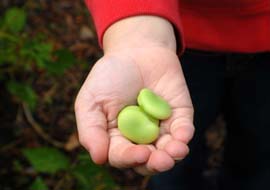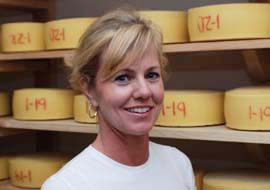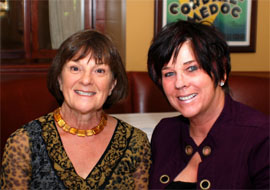Fresh Thinking
Tackling childhood obesity, one bite at a time.
You might say that David Haskell, director of the Garden of Eatin’ Institute, is planting the seeds for a healthier future—literally. His 10,000-square foot garden at the North Bay Children’s Center is the regional model for nine California schoolyard gardens, created to educate and inspire young people about the advantages of healthy, natural foods.
In a world where sodas and sweet juices flow freely and fast food is the norm, David teaches preschoolers to understand and value simple foods, grown and prepared with care and attention. The journey of enlightenment begins at ground level, where kids learn first-hand the work and rewards of planting, tending and harvesting fruits and vegetables. Ultimately, children bring their newfound knowledge home, helping their families make better food choices every day.
David and I took a break from touring the garden to chat in-depth about food, health and the not-so-sweet side of sugar.
![]() BA: David, I knew that the American obesity problem was serious but was shocked to learn that 32% or 25 million kids are affected. I remember when we ate a diet rich in fresh fruits and vegetables but kids today can’t identify the most basic ones, let alone eat them on a regular basis. What happened? How did we become such an unhealthy society?
BA: David, I knew that the American obesity problem was serious but was shocked to learn that 32% or 25 million kids are affected. I remember when we ate a diet rich in fresh fruits and vegetables but kids today can’t identify the most basic ones, let alone eat them on a regular basis. What happened? How did we become such an unhealthy society?
![]() DH: We’re a market-oriented society driven by profit. We are the commodity driven to buy and eat more and more. The problem is that humans are set to consume 1,500 to 2,000 calories per day for good health, and marketing has increased that to 4,000 calories.
DH: We’re a market-oriented society driven by profit. We are the commodity driven to buy and eat more and more. The problem is that humans are set to consume 1,500 to 2,000 calories per day for good health, and marketing has increased that to 4,000 calories.
BA: When did the childhood obesity epidemic begin?
DH: About 30 years ago. We can trace its beginnings to the introduction of high fructose corn syrup as a cheap alternative to sugar. It’s in thousands of food products and fast foods today. And to drive profits, companies introduced and promote large and super-sized portions.
BA: If I remember correctly soft drinks were once 8-ounces and are now as high as 64-ounces. How one person can drink that much is beyond me. What’s the difference in our sugar consumption today compared to earlier generations?
DH: That’s easy—our ancestors 110 years ago consumed 8 pounds of sugar per person a year; today it’s 140 pounds per person. As parents and educators, we must reduce the amount of sugar our kids are consuming.
BA: Agreed. Parents must be vigilant but it’s not easy. Did you know that they put sugar in the milk kids drink to make it taste good?
DH: …and it’s in baby food and formula. It’s even harder when these poor little guys go to a birthday party and get cake with frosting, ice cream, candy and sweet drinks. And it continues throughout the year during holidays like Christmas and Easter where sweets are at every turn.
BA: How do you wean the kids off high fructose corn syrup and sugar, especially when advertisers attach their favorite movie and cartoon characters to products to increase sales and consumption?
DH: We immerse them in eating fresh fruits and vegetables from the garden. You must train their taste buds at this early age–enliven them—so we conduct lots of taste tests. Maybe a just-harvested bean tasted raw, then steamed and one from the supermarket. Kids can identify the sweet, tasty bean right away and quickly learn the difference.
BA: So what happens when a kid trained in a garden encounters tempting sweet treats?
DH: Barbara, one of my favorite stories about one of our students happened when she went to a church social event. She spotted a long table filled with beautiful cakes and baked goods and a lone plate of fruit and raw vegetables. She walked slowly up and down the table studying everything then selected a carrot. Imagine! A carrot over cake.
BA: David, how do you get the parents to support the program when we’ve become such a convenience-focused society? Parents are overworked and exhausted and looking for cheap, tasty, quick and easy meals that are boxed, bottled or frozen. Fast food for the entire family is often cheaper than fresh produce. What do you say to them?
DH: What is convenience when the food you feed your kids makes them sick? You have to think of the long-term. How convenient is it when your kid gets type-2 diabetes with all its complications, or high blood pressure and cholesterol? Did you know that it costs 15,000 dollars a year to treat diabetes; that’s a million dollars over a lifetime? Of course that figure doesn’t include complications. What price convenience? Parents and grandparents save for college, why not spend money on food that nourishes and strengthens them now?
BA: I know that your institute builds gardens, but you also promote increased physical activity for good health as a deterrent against obesity.
DH: Parents are so obsessed with paying the mortgage that they have no time to direct the kids playtime. Did you know that 97% of the kids in the 1950s played outdoors; today it’s 3%. What happened to jump rope and hopscotch? Today kids are housebound on their computers, watching endless television, playing video games and listening to their IPods.
How do the kids get any real life experiences? They are missing all of the opportunities to grow and mature, to physically engage in the environment around them. As a society, we’ve abdicated our parental responsibilities to set the rules; instead corporations are dictating the way while watching their profits grow.
BA: What can parents do to change things at home?
DH: Two things are absolutely necessary. First, cut out all sodas and juices. We no longer allow them at school because they are a sugar highway. Think of it this way: nature gave us fiber with natural sugar when we eat fruit like an apple. The fiber slows the sugar absorptions and the body processes it correctly. Juice that apple and it becomes a river stored quickly. You won’t know when you’re full even though your stomach is. If you consume lots of sugar like this, you can become insulin resistant and develop type-2 diabetes. We’re also seeing an increase in fatty liver syndrome where the liver ceases to function. This is fatal and cannot be managed like diabetes.
BA: What’s the second recommendation?
DH: Eliminate television. The single greatest factor of poor health is exposure to the media. Kids and their families see non-stop marketing messages to buy products with high fructose, sugar, salt and fat. They are particularly vulnerable to ads for products with their favorite movie and cartoon characters.
Think about it, kids are surrounded by TVs; they’re even in their bedrooms. Did you know that for every hour a child watches TV their risk for diabetes goes up 7%?
BA: That’s terrible! Just think about the risk of someone who watches 5 or 6 hours a day.
DH: Barbara, this is the first generation sickened by advertising. This childhood obesity epidemic is like a forest fire and gardens are the water to put it out.
BA: I agree that gardens—pardon the pun—are a great way to return to our roots—to the earth. But let’s face it; gardens are simply not possible for many families with limited or no land. As parents what can we do?
DH: We can build community gardens with intention. Children’s nutritional gardens. They must be places where parents can take their kids, much like community health centers. These gardens will help nourish and raise healthy kids that mature and spread their knowledge and experiences to the next generation. Gardens built with intention equals health.
BA: At least today children’s health issues are finally becoming a priority. Look at the wonderful work that Michelle Obama has started. We now have an organic garden at the White House and a plan with defined goals set for raising healthy kids and reducing childhood obesity rates to 5% by 2030. How can our schools get involved?
DH: There is definitely a convergence happening in this country today. More and more people have an appreciation of what’s needed and are working to change things.
Many kids go to childcare centers today, so we must start by reforming the early childhood programs to put health at the core. Kids with strong physical and emotional health are full of potential and do better in the classroom.
BA: We definitely have our work cut out for us, but the rewards are immense. Imagine the power of one child changing the way his or her family makes food choices—and that ripples through the community and across the country. It’s truly an investment in our future; maybe the most important one we’ll ever make.










